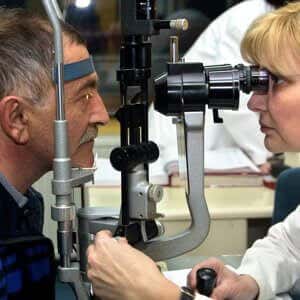
Baby boomers may acknowledge that birthdays happen, but they never thought they’d grow old like their parents and grandparents. A new report shows they were right in one respect: they have not developed age-related macular degeneration (AMD) at the same rate as previous generations (Cruickshanks et al, JAMA Ophthalmology, online Nov. 16, 2017).
Rates of AMD Dropped Each Generation:
In age-related macular degeneration, the center, or macula, of the retina degrades. As that part of the eye deteriorates, people lose the ability to see what is in the center of their visual field. As a result, they may not be able to see well enough to function.
In this longitudinal cohort study, eye doctors examined middle-aged and older adults in Beaver Dam, Wisconsin, in 1987 and 1988. Their adult children underwent eye exams from 2005 to 2008. Pictures that were taken of the retina suggested that nearly 5,000 individuals would be likely to develop AMD. However, the investigators found dramatic differences in the rates of progression to this condition from one generation to the next.
The Greatest Generation Had the Greatest Risk:
The scientists found rates of AMD among the “greatest generation” (born between 1901 and 1924) were highest, at 8.8 percent overall. People in the “silent generation” (born between 1925 and 1945) had a lower rate: 3 percent. In contrast, baby boomers (born from 1946 to 1964) have just a 1 percent rate so far. And Generation X (1965-1984), while younger, has the lowest rate of all, at just 0.3 percent.
Some of these differences might be accounted for by the fact that boomers and Gen-Xers aren’t yet very old. (The oldest boomers are 70.) However, the data show lower rates in each age category.
Consequently, the researchers concluded that:
“The 5-year risk for AMD declined by generation throughout the 20th century.”
The reasons for this improvement are unknown.
What You Can Do About AMD:
Previous research has shown that people who take a specific vitamin formula (AREDS) delay their progression of macular degeneration. Certain drugs (bevacizumab and ranibizumab) that interfere with exuberant blood vessel development can also help slow “wet” macular degeneration.
Watch Out for Aspirin:
Be sure to ask your eye doctor before starting a regimen of aspirin, as that could contribute to an increased risk of AMD. Australian researchers found a link between regular aspirin use and the risk of wet macular degeneration (Liew et al, JAMA Internal Medicine, Feb. 25, 2013).
In the Blue Mountain Eye Study, investigators followed more than 2,000 subjects for up to 15 years. During the decade and a half, they examined the participants’ eyes on four separate occasions. They took special photographs of the volunteers’ retinas to assess whether they had developed macular degeneration. Nearly 10% of the people in the trial took aspirin (150 mg/day) on a regular basis.
After 15 years, wet macular degeneration appeared about twice as often in the aspirin users as in those who did not take aspirin. Over the entire 15-year period, about 9 percent of the aspirin users and almost 4 percent of those not using aspirin had developed wet macular degeneration. The investigators concluded that this risk is too small to change clinical practice at this time.
An accompanying commentary in JAMA Internal Medicine concluded that
“decisions about aspirin use are best made by balancing the risks against the benefits in the context of each individual’s medical history and value judgments.”

